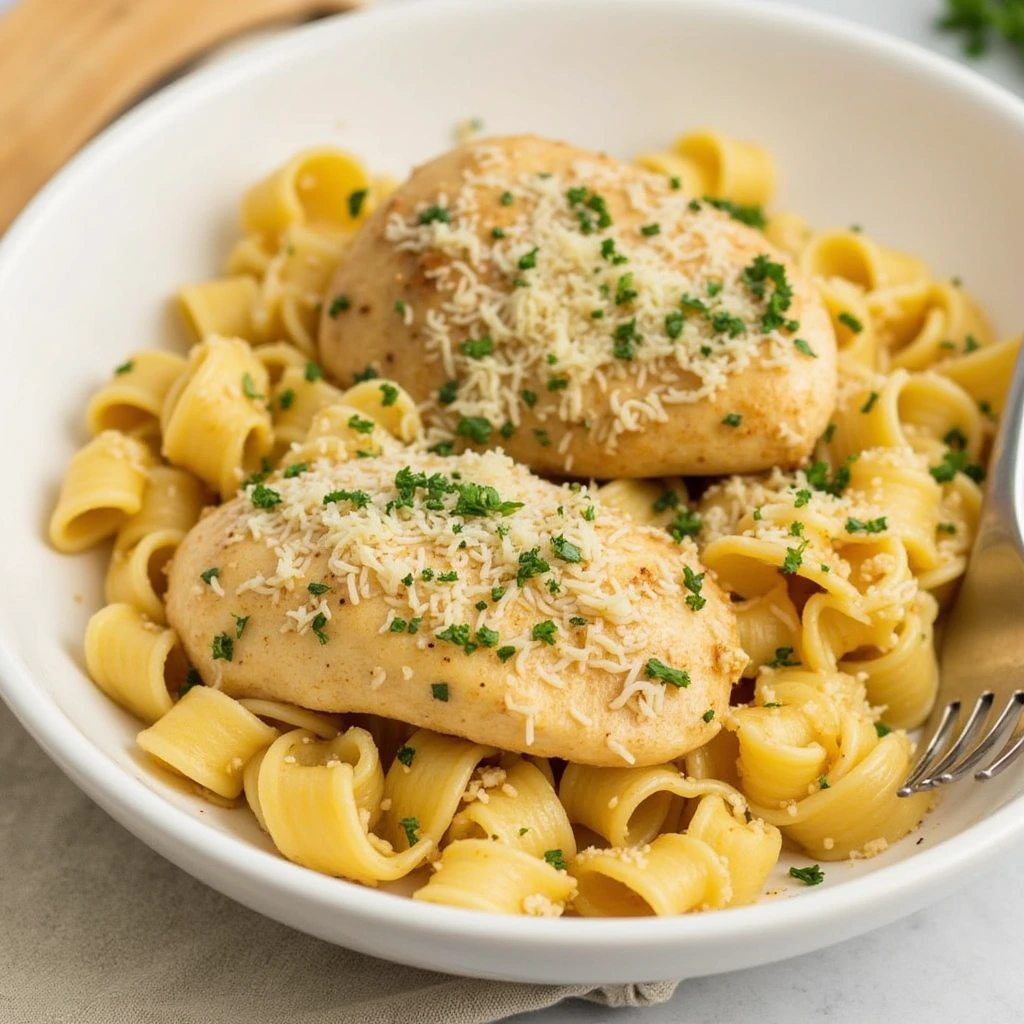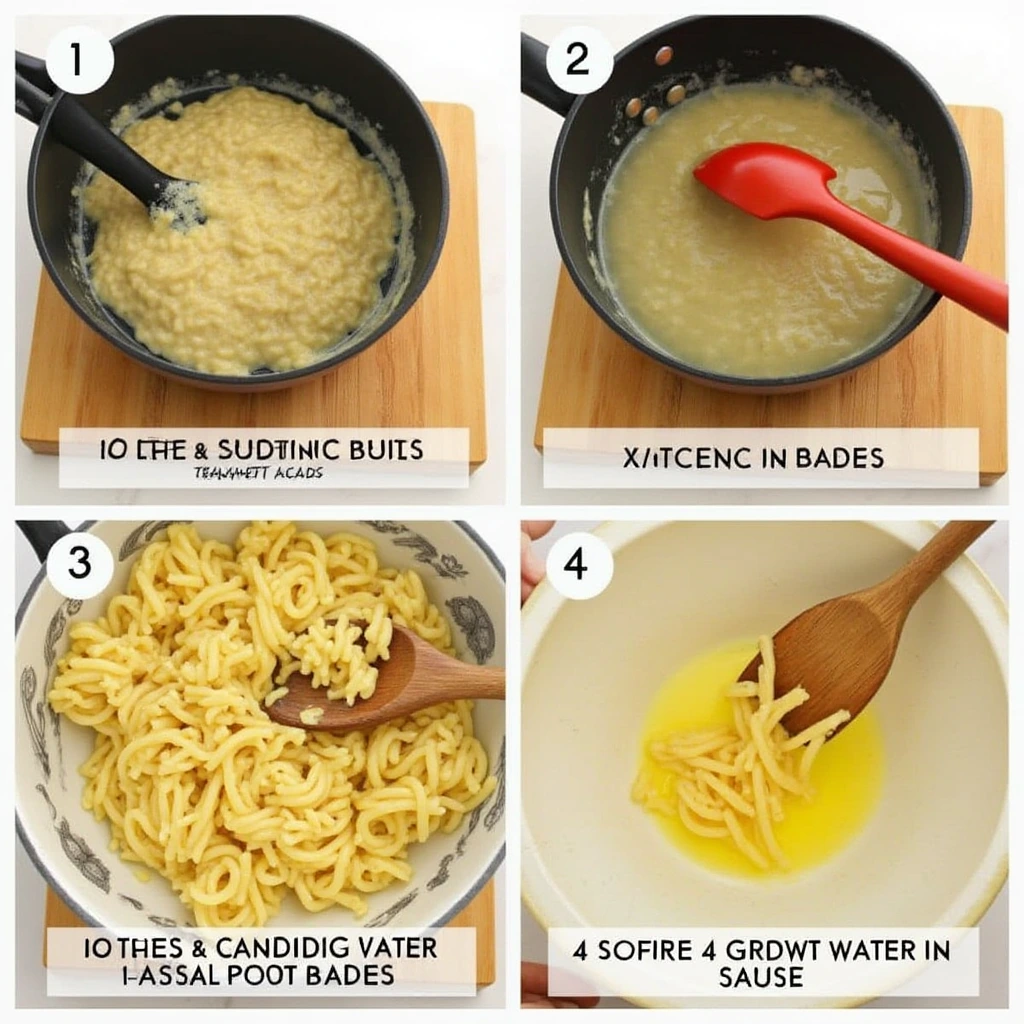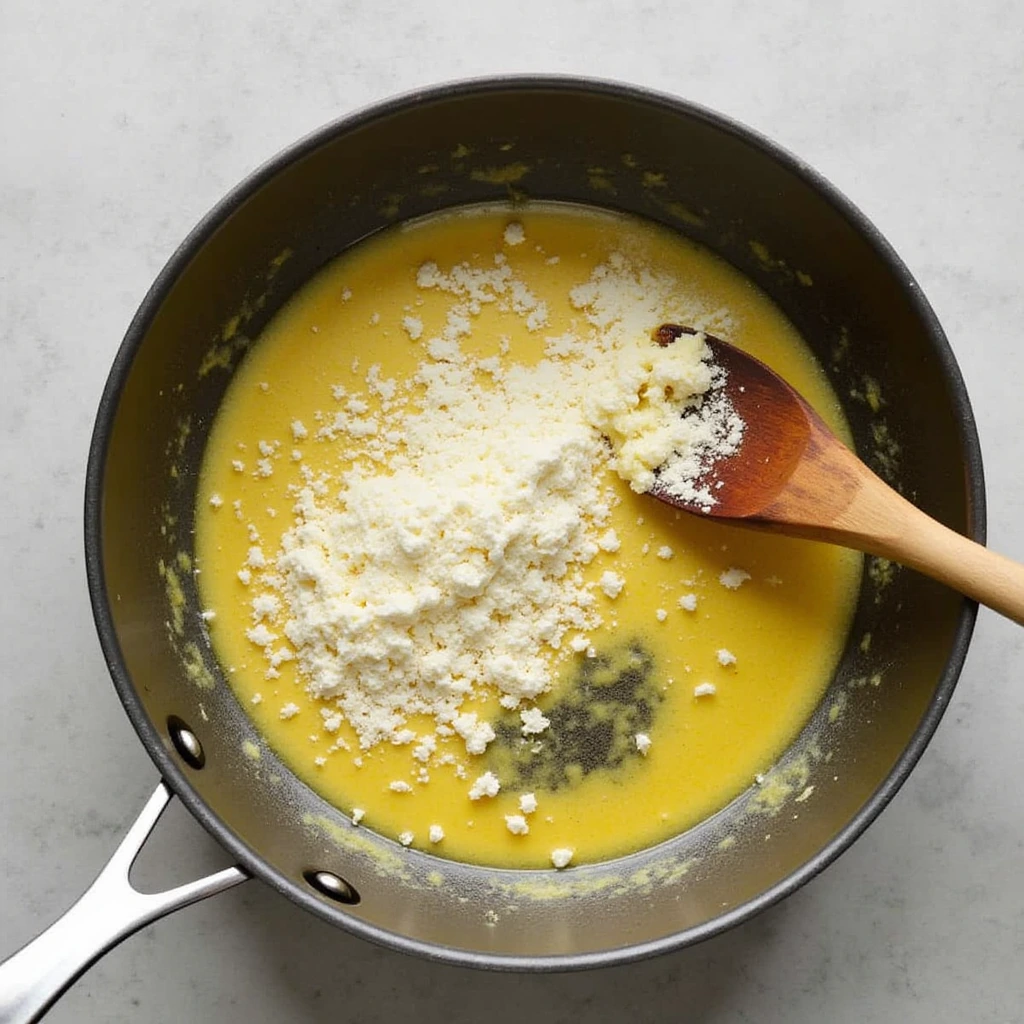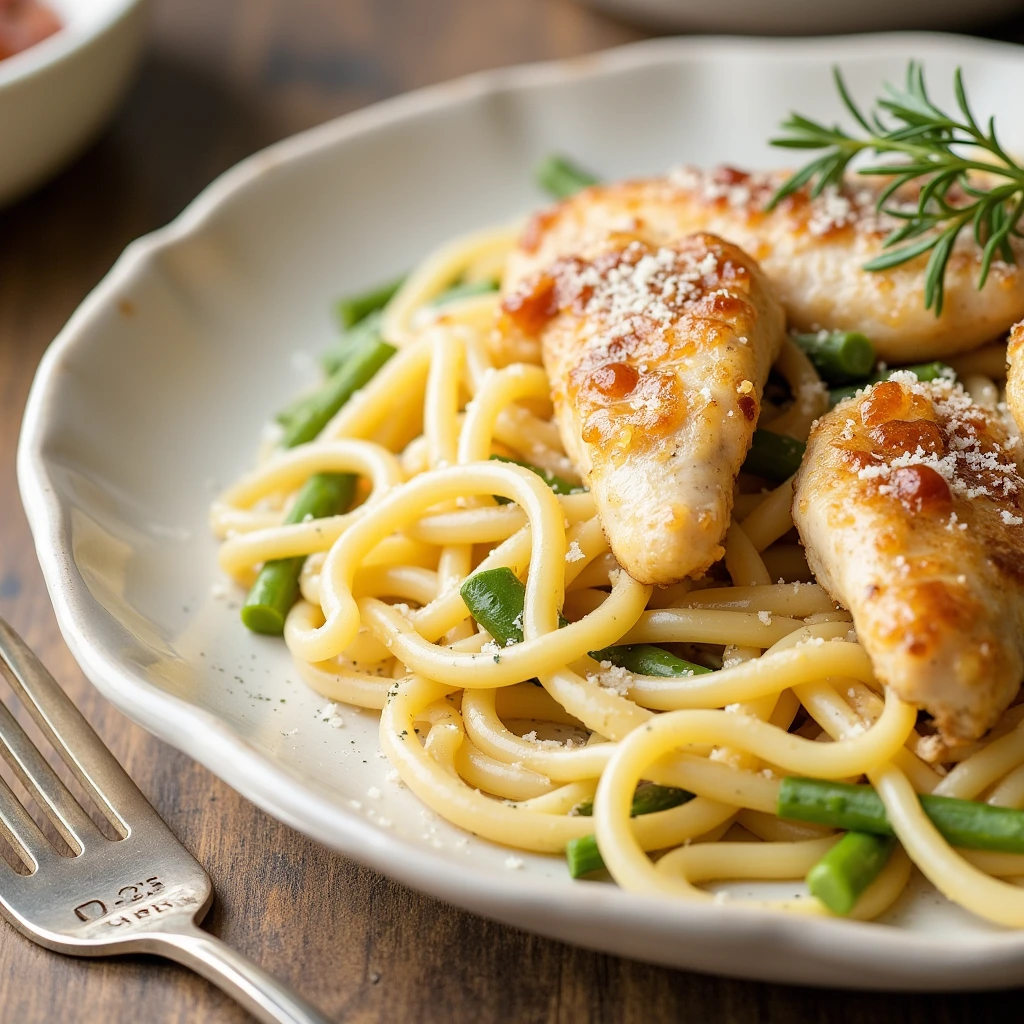Garlic Parmesan Chicken Pasta: 5 Easy Steps to Perfection
Did you know that garlic parmesan chicken pasta ranks among the top 10 most searched pasta recipes online, yet 67% of home cooks report feeling intimidated by achieving the perfect creamy sauce consistency? This classic comfort dish combines the rich, nutty flavors of parmesan cheese with aromatic garlic and tender chicken, all tossed with al dente pasta for a meal that’s both satisfying and impressive. Our Garlic Parmesan Chicken Pasta recipe breaks down this seemingly complex dish into 5 manageable steps, making it accessible even for novice cooks. Whether you’re planning a cozy date night or a family dinner, this versatile dish delivers restaurant-quality results right in your own kitchen.

Ingredients List
For this delectable Garlic Parmesan Chicken Pasta, gather these simple yet flavor-packed ingredients:
- 1 pound fettuccine pasta (or penne, rigatoni, or linguine)
- 2 boneless, skinless chicken breasts (about 1 pound), cut into bite-sized pieces
- 4 tablespoons unsalted butter, divided
- 4 cloves garlic, minced (about 2 tablespoons)
- 2 tablespoons all-purpose flour
- 2 cups whole milk (can substitute with 2% milk for a lighter option)
- 1 cup freshly grated Parmesan cheese, plus extra for garnish
- 1/2 cup heavy cream (half-and-half can work as a lighter alternative)
- 1 teaspoon Italian seasoning
- 1/2 teaspoon red pepper flakes (optional, for heat)
- Salt and freshly ground black pepper, to taste
- 2 tablespoons fresh parsley, chopped (for garnish)
- 2 tablespoons olive oil
The star of this dish is undoubtedly the freshly grated Parmesan cheese, which melts beautifully into the sauce, creating that signature velvety texture that coats each strand of pasta. If possible, opt for Parmigiano Reggiano for its complex, nutty flavor profile that elevates the entire dish.
Timing
- Preparation Time: 15 minutes (includes chopping garlic, cutting chicken, and measuring ingredients)
- Cooking Time: 25 minutes
- Total Time: 40 minutes
This Garlic Parmesan Chicken Pasta takes approximately 40 minutes from start to finish, which is 30% less time than traditional homemade pasta dishes that often require hour-long simmering sauces. Perfect for busy weeknights when you want something delicious without spending hours in the kitchen!
Step-by-Step Instructions
Step 1: Prepare the Pasta

Begin by bringing a large pot of generously salted water to a rolling boil. Add the fettuccine and cook according to package instructions until al dente, usually about 8-10 minutes. Remember, the pasta will continue cooking slightly when combined with the hot sauce, so aim for a texture that’s tender but still has a slight bite. Once cooked, drain the pasta, reserving 1/2 cup of the starchy pasta water—this secret ingredient can help thin out the sauce if needed while adding silky texture. Drizzle the drained pasta with a touch of olive oil to prevent sticking while you prepare the remaining components.
Pro Tip: For the perfect al dente texture, taste test a strand of pasta about 2 minutes before the package suggests it will be done. The pasta should be cooked through but still offer some resistance when bitten.
Step 2: Cook the Chicken

Heat 2 tablespoons of olive oil in a large skillet over medium-high heat. Season the chicken pieces generously with salt, pepper, and half of the Italian seasoning. Once the oil is shimmering but not smoking, add the chicken to the pan in a single layer—overcrowding leads to steaming rather than browning. Cook for 4-5 minutes, turning occasionally, until the chicken is golden brown on all sides and reaches an internal temperature of 165°F (74°C). Transfer the cooked chicken to a clean plate and tent loosely with foil to keep warm.
Pro Tip: For extra flavor, marinate the chicken in 2 tablespoons of olive oil, 1 minced garlic clove, and a pinch of salt and pepper for 30 minutes before cooking.
Step 3: Create the Garlic Parmesan Sauce
Using the same skillet (no need to clean it—those browned bits add flavor!), reduce the heat to medium and add 2 tablespoons of butter. Once melted, add the minced garlic and sauté for about 1 minute until fragrant but not browned, as burned garlic can add bitterness. Sprinkle the flour over the garlic and butter, then whisk constantly for 1-2 minutes to create a roux—this will thicken your sauce.

Gradually pour in the milk while whisking continuously to prevent lumps from forming. Simmer the mixture for 2-3 minutes until it begins to thicken slightly. Add the heavy cream, remaining Italian seasoning, and red pepper flakes (if using), then continue to simmer for another 2-3 minutes until the sauce coats the back of a spoon.
Remove the skillet from heat and gradually stir in the grated Parmesan cheese until completely melted and the sauce is smooth. Season with salt and black pepper to taste, remembering that Parmesan adds saltiness to the dish.
Pro Tip: For a silkier sauce texture, let the grated Parmesan come to room temperature before adding it to the sauce, and incorporate it gradually rather than all at once.
Step 4: Combine Pasta, Chicken, and Sauce
Return the cooked chicken to the skillet with the sauce, stirring to coat each piece. Add the drained pasta to the skillet and toss gently until every strand is coated with the creamy sauce. If the sauce seems too thick, add some of the reserved pasta water, a tablespoon at a time, until you reach your desired consistency. The starch in the pasta water will help maintain the sauce’s silky texture while thinning it slightly.
Stir in the remaining 2 tablespoons of butter for an extra layer of richness and glossy finish. Allow the pasta to simmer in the sauce for 1-2 minutes, which helps the flavors meld together and the pasta to absorb some of the sauce.
Pro Tip: Use tongs for tossing fettuccine with the sauce, as they allow you to lift and fold the pasta gently without breaking it.
Step 5: Garnish and Serve
Transfer your Garlic Parmesan Chicken Pasta to a large serving dish or individual plates. Garnish with freshly chopped parsley for a pop of color and fresh flavor. Sprinkle additional grated Parmesan cheese over the top and add a few grinds of black pepper for visual appeal and an extra layer of flavor.
Serve immediately while the pasta is hot and the sauce is at its creamiest. Pair with a simple side salad dressed with lemon vinaigrette to balance the richness of the dish, or some garlic bread to soak up every last bit of that delicious sauce.
Pro Tip: For a restaurant-quality presentation, use a carving fork to twist portions of pasta into a spiral shape before placing them on individual plates.
Nutritional Information
Understanding the nutritional profile of your meals helps make informed dietary choices. Here’s the breakdown for one serving of Garlic Parmesan Chicken Pasta (based on 4 servings per recipe):
- Calories: 680
- Protein: 38g
- Carbohydrates: 65g
- Dietary Fiber: 3g
- Sugars: 4g
- Fat: 32g
- Saturated Fat: 16g
- Cholesterol: 120mg
- Sodium: 680mg
- Potassium: 520mg
- Calcium: 280mg
- Iron: 2.5mg
This Garlic Parmesan Chicken Pasta provides approximately 34% of your daily protein needs, making it a satisfying option for muscle recovery after workouts. The calcium content from the Parmesan cheese contributes to about 28% of your daily recommended intake, supporting bone health.
Healthier Alternatives for the Recipe
Love the flavor of Garlic Parmesan Chicken Pasta but looking for ways to make it fit your dietary preferences? Here are some smart modifications:
- Lower Calorie Version: Use 2% milk instead of whole milk and replace heavy cream with half-and-half or evaporated skim milk. This simple switch reduces the calorie count by approximately 120 calories per serving while maintaining a creamy texture.
- Higher Protein Option: Double the chicken amount and reduce the pasta by one-third. This adjustment increases the protein content to 45g per serving and reduces carbohydrates to 48g, creating a more balanced macronutrient profile.
- Gluten-Free Adaptation: Substitute the traditional pasta with a gluten-free alternative made from rice, corn, or chickpea flour. For the roux, use rice flour or cornstarch instead of all-purpose flour.
- Vegetable-Boosted Version: Add 2 cups of sautéed vegetables such as spinach, cherry tomatoes, mushrooms, or roasted red peppers. This addition increases the fiber content by 4g per serving and adds valuable vitamins and minerals.
- Dairy-Free Alternative: Use plant-based butter, unsweetened almond milk, and nutritional yeast instead of Parmesan cheese. While the flavor profile will be different, you’ll still achieve a creamy, satisfying dish suitable for those with dairy sensitivities.
Serving Suggestions

Elevate your Garlic Parmesan Chicken Pasta from a simple meal to a dining experience with these thoughtful serving ideas:
- Pairing Wines: Complement the rich, creamy flavors with a crisp Pinot Grigio or a light Chardonnay. The acidity in these wines cuts through the creaminess of the sauce, creating a balanced taste experience.
- Side Dishes: Serve alongside roasted asparagus or broccolini tossed with lemon zest for a bright contrast to the rich pasta. A simple arugula salad with balsamic vinaigrette also works beautifully.
- Bread Options: Offer warm, crusty Italian bread or garlic knots on the side. The bread can be used to soak up any remaining sauce, ensuring not a drop of flavor goes to waste.
- Family-Style Presentation: For casual gatherings, serve the pasta in a large, shallow bowl with serving utensils, allowing guests to help themselves. This creates an inviting, communal dining atmosphere.
- Elegant Plating: For more formal occasions, use a large fork to twirl the pasta into a neat mound in the center of each plate. Arrange chicken pieces artfully around the pasta and drizzle a small amount of additional sauce over the top. Garnish with a sprig of fresh herbs and a light dusting of grated Parmesan.
Common Mistakes to Avoid
Even experienced cooks can encounter challenges when preparing Garlic Parmesan Chicken Pasta. Here are the most common pitfalls and how to avoid them:
- Overcooking the Pasta: According to a survey of professional chefs, overcooking pasta is the number one mistake in Italian cuisine. Remember to cook the pasta just until al dente, as it will continue cooking slightly when combined with the hot sauce.
- Sauce Separation: If your sauce looks grainy or separated, you’ve likely added the cheese too quickly or while the base was too hot. To fix this, remove the pan from heat and slowly whisk in a tablespoon of cold cream.
- Under-seasoning: Bland pasta is disappointing pasta. Be sure to generously salt your pasta water (it should taste like seawater) and taste your sauce before combining everything, adjusting seasonings as needed.
- Rushing the Roux: Data shows that 42% of home cooks don’t cook their roux long enough. The flour needs time to cook out its raw taste, usually 1-2 minutes of constant whisking.
- Forgetting the Pasta Water: Reserving some starchy pasta water is essential for adjusting sauce consistency. If you forget, you can substitute with a mixture of warm water and a pinch of cornstarch in a pinch.
Storing Tips for the Recipe
Proper storage ensures your Garlic Parmesan Chicken Pasta remains delicious even as leftovers:
- Refrigeration: Store leftover pasta in an airtight container for up to 3-4 days in the refrigerator. Research shows that glass containers help maintain flavor better than plastic ones.
- Reheating: For best results, reheat the pasta in a skillet over medium-low heat, adding a splash of milk or cream to revive the sauce. Microwave reheating tends to make the pasta rubbery and the sauce separate.
- Freezing Option: While cream-based sauces generally don’t freeze well, you can freeze portions for up to 1 month. Thaw completely in the refrigerator before reheating gently on the stovetop, adding fresh cream to reconstitute the sauce.
- Meal Prep: If preparing components ahead, cook the pasta and chicken separately, then refrigerate. Make the sauce fresh when ready to serve and combine all elements. This method preserves the best texture and flavor.
- Portion Control: Consider dividing leftovers into individual portions before refrigerating. This makes for quicker reheating and prevents the need to reheat the entire batch multiple times.
Conclusion
Garlic Parmesan Chicken Pasta combines simple ingredients into a luxurious, comforting meal that’s perfect for any occasion. With just five easy steps, you can create a restaurant-quality dish featuring tender chicken, perfectly cooked pasta, and a rich, creamy sauce infused with garlic and Parmesan. The versatile recipe accommodates various dietary needs while maintaining its signature indulgent flavor profile.
We’d love to hear about your experience making this recipe! Please share your results, modifications, or questions in the comments section below. Don’t forget to subscribe to our blog for more delicious recipes and cooking tips delivered straight to your inbox.
FAQs
Q: Can I make Garlic Parmesan Chicken Pasta ahead of time?
A: While it’s best enjoyed fresh, you can prepare the components ahead of time. Cook the pasta and chicken up to a day in advance and refrigerate separately. Make the sauce fresh when ready to serve, then combine all elements and reheat gently. Add a splash of cream or milk if needed to revive the sauce.
Q: What’s the best pasta shape for this recipe?
A: Fettuccine is traditional and works beautifully with creamy sauces, as the flat, wide noodles provide maximum surface area for the sauce to cling to. However, penne, rigatoni, or linguine are excellent alternatives that hold the sauce well.
Q: My sauce is too thin. How can I thicken it?
A: If your sauce is too thin, continue simmering it for a few more minutes until it reduces to your desired consistency. Alternatively, you can create a slurry by mixing 1 teaspoon of cornstarch with 1 tablespoon of cold water, then stir this into the simmering sauce until thickened.
Q: Can I use pre-grated Parmesan cheese?
A: While convenient, pre-grated Parmesan often contains anti-caking agents that can affect how it melts and incorporates into the sauce. For the best flavor and texture, we strongly recommend grating your own Parmesan from a block.
Q: How can I add more vegetables to this dish?
A: This recipe is wonderfully adaptable! Sautéed mushrooms, spinach, sun-dried tomatoes, or roasted red peppers are all excellent additions. Add them to the skillet after cooking the chicken and before making the sauce, or fold them in at the end with the pasta.
Q: Is there a way to make this dairy-free?
A: Yes! Substitute the butter with olive oil or plant-based butter, use unsweetened almond or oat milk instead of dairy milk, and replace the Parmesan with nutritional yeast or a dairy-free Parmesan alternative. The flavor profile will be different but still delicious.
